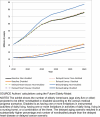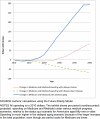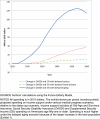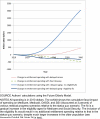Substantial health and economic returns from delayed aging may warrant a new focus for medical research
- PMID: 24101058
- PMCID: PMC3938188
- DOI: 10.1377/hlthaff.2013.0052
Substantial health and economic returns from delayed aging may warrant a new focus for medical research
Abstract
Recent scientific advances suggest that slowing the aging process (senescence) is now a realistic goal. Yet most medical research remains focused on combating individual diseases. Using the Future Elderly Model--a microsimulation of the future health and spending of older Americans--we compared optimistic "disease specific" scenarios with a hypothetical "delayed aging" scenario in terms of the scenarios' impact on longevity, disability, and major entitlement program costs. Delayed aging could increase life expectancy by an additional 2.2 years, most of which would be spent in good health. The economic value of delayed aging is estimated to be $7.1 trillion over fifty years. In contrast, addressing heart disease and cancer separately would yield diminishing improvements in health and longevity by 2060--mainly due to competing risks. Delayed aging would greatly increase entitlement outlays, especially for Social Security. However, these changes could be offset by increasing the Medicare eligibility age and the normal retirement age for Social Security. Overall, greater investment in research to delay aging appears to be a highly efficient way to forestall disease, extend healthy life, and improve public health.
Keywords: Financing Health Care; Health Spending; Medical Technology.
Figures




References
-
- Congressional Budget Office . The 2012 long-term budget outlook [Internet] CBO; Washington (DC): Jun, 2012. [2013 Aug 27]. (Pub. No. 4507). Available from: www.cbo.gov/sites/default/files/cbofiles/attachments/06-05-Long-Term_Bud....
-
- Lakdawalla DN, Bhattacharya J, Goldman DP. Are the young becoming more disabled? Health Aff (Millwood) 2004;23(1):168–76. - PubMed
-
- Hulsegge G, Picavet HS, Blokstra A, Nooyens AC, Spijkerman AM, van der Schouw YT, et al. Today's adult generations are less healthy than their predecessors: generation shifts in metabolic risk factors: the Doetinchem Cohort Study. Eur J Prev Cardiol. 2013 Apr 15; [Epub ahead of print] - PubMed
Publication types
MeSH terms
Grants and funding
LinkOut - more resources
Full Text Sources
Other Literature Sources
Medical

